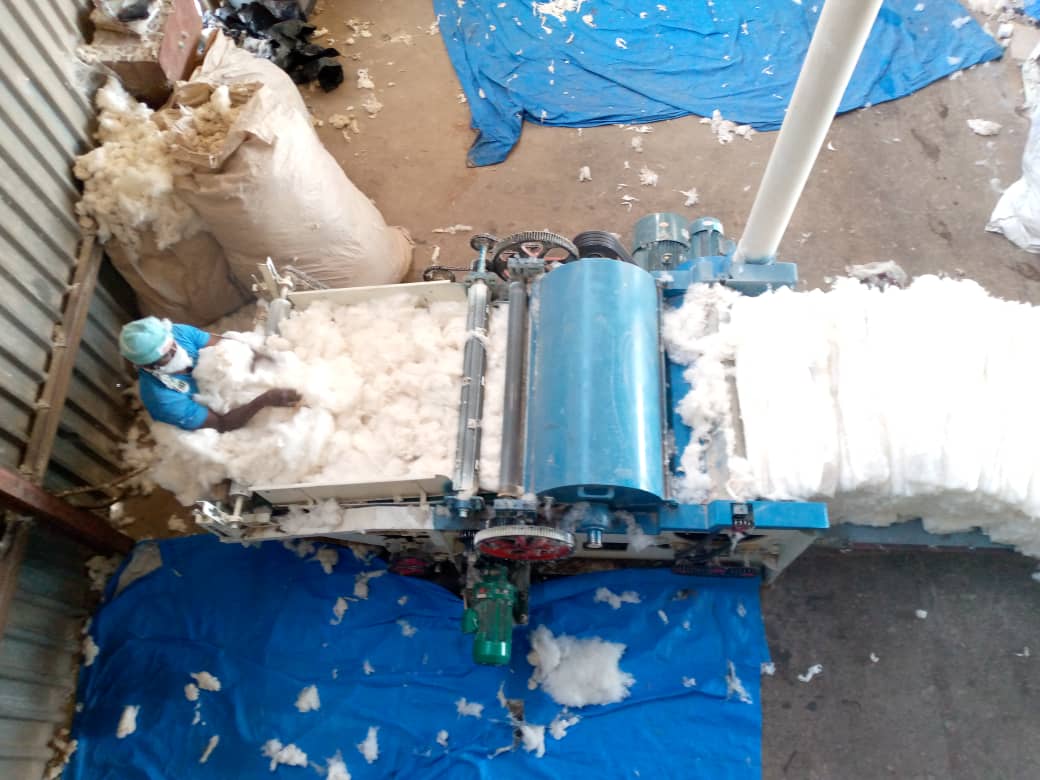UNCTAD supports efforts to add value to cotton by-products in eastern and southern Africa to make the crop more profitable for farmers.
© Cotton Association of Zambia
Zambia produces about 55,000 metric tons of raw cotton each year.
After processing, it exports most of its raw lint without adding any value to the fibre and imports most of its absorbent cotton wool products such as ear buds and swabs.
This robs the country’s entrepreneurs of the business opportunities created by adding value to the raw lint.
But one Zambian entrepreneur is determined to change the situation.
Carrivorious Simasinti’s firm, Premier Multipurpose Cooperative Society Limited, processes raw lint into absorbent or surgical cotton wool for medical and sanitary use.
Founded in 2016, the firm is ramping up operations to meet the rising demand for absorbent cotton wool products in the country and the southern African region.
“We’re expanding our value-added activities to capitalize on the growing market opportunity,” Mr. Simasinti said.
Unlocking cotton’s hidden value
Mr. Simasinti (far left) during the study visit to India
Mr. Simasinti got help from an UNCTAD project that sought to develop value-added processing of cotton by-products in eastern and southern Africa.
The project empowered him and others to unlock the business opportunities contained in cotton by-products.
Among other activities, the project organized a study visit to India in 2019 for him and other cotton entrepreneurs from Uganda, Zambia and Zimbabwe.
Mr. Simasinti visited a profitable small-scale absorbent cotton wool plant, built with used machinery, which corresponded to the scale of his own venture.
“I learned more about machinery for the production and processing of various cotton by-products,” he said.
He also learned how to cash in on cotton residues by making fuel briquettes from cotton stalks, absorbent cotton from waste fibres and cottonseed meal that can be fed to poultry and other non-ruminants.
He established a relationship with the owner of the Indian plant, who shared detailed advice on business and marketing, as well as referrals to suppliers of used machinery.
Along with his own hard work and ingenuity, Mr. Simasinti used the lessons, information and contacts he acquired through the UNCTAD project to draft a detailed investment plan, largely based on importing used machinery.
The lessons he learned helped him select a machinery supplier from China.
A factory upgrade
A worker in Mr. Simasinti's factory processes surgical cotton wool.
With financial support from various investors, in September last year Mr. Simasinti embarked on upgrading his factory, which he had initially set up with improvised machinery.
The equipment from the Chinese supplier boosted productivity and improved the quality of the firm’s surgical cotton wool.
The factory now produces an average of 7,200 kilograms of surgical cotton wool monthly, of which 70% is sold locally and 30% is exported to neighbouring countries by traders.
Thanks to the increased productivity, Mr. Simasinti has created 11 new jobs at the factory. Most of his 21 workers are involved in cotton treatment, drying, packing and other processes of the production cycle.
He has also contracted 119 farmers to supply the raw cotton his factory needs through a new “outgrower scheme” that was not in place before the study visit.
Outgrower schemes are the standard production model in many African countries. According to these contracts, farmers commit to grow and sell their cotton to a buyer, in return for the latter providing agricultural inputs and some training during the growing season.
The farmers cover 250 hectares of planted fields and are expected to produce 150 tons of seed cotton at an average of 600 kilograms per hectare.
COVID-19’s silver lining
In the wake of COVID-19, Mr. Simasinti’s firm has seen increased demand for its products within and outside the country.
“Demand is so high that everything we produce is sold out,” he said.
Most of the firm’s customers are pharmaceutical companies, chemists and wholesalers in the Zambian capital Lusaka. Its cotton wool is also used in government hospitals.
The firm’s annual income now tops $72,000, a 92% jump from its earnings before the study visit. But Mr. Simasinti believes it could generate more if it overcame some challenges.
These include limited availability of raw materials and lack of adequate machinery for some production processes such as drying cotton during the rainy season.
The firm also lacks proper means of transport for deliveries and for supervision of activities in the outgrower scheme.
Mr. Simasinti is looking for funds to tackle these challenges and acquire state-of-the-art machinery to intensify production and increase the firm’s revenues.
“We’d like to invest in our own ginnery and expand our outgrower scheme to get more raw materials,” he said.
Improved processing activities can also increase the farmers’ incomes and help reinvigorate the cotton value chain in the country.



